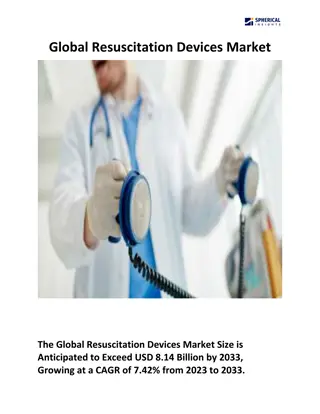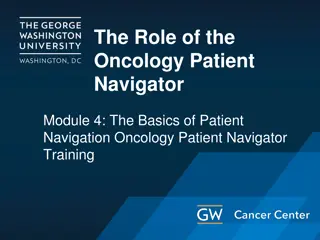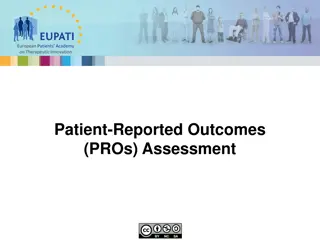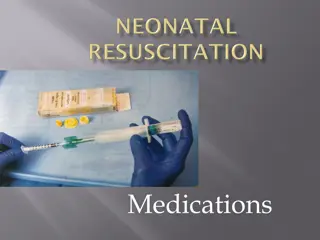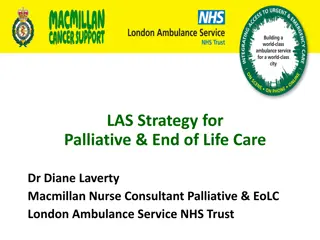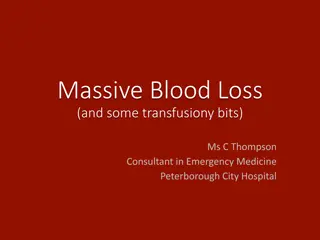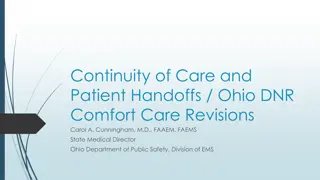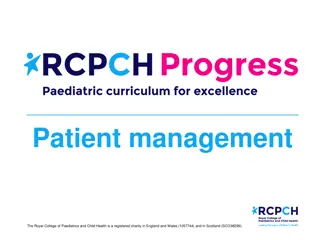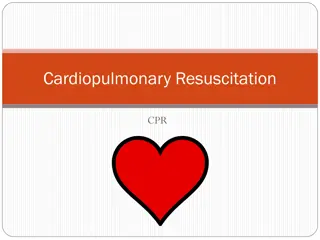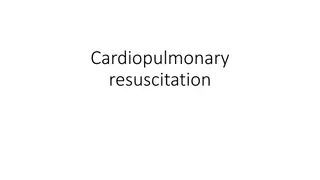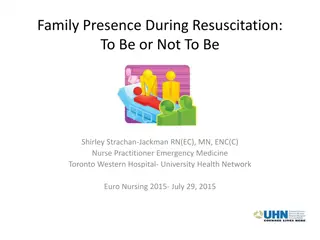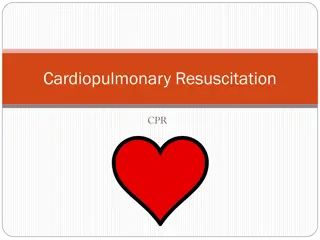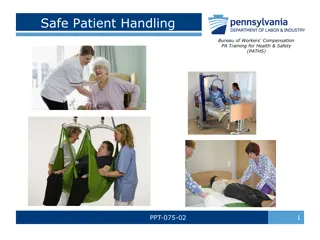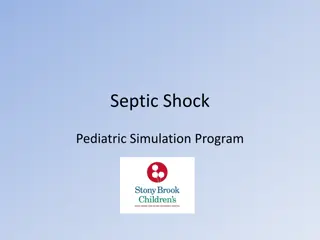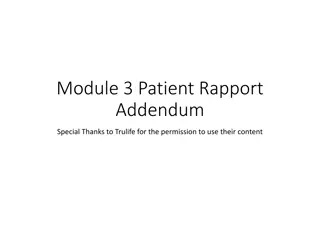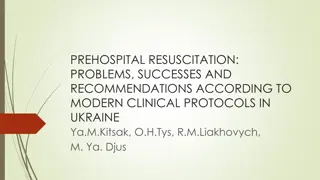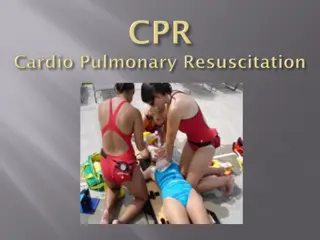Modernize Patient Experience with Digital Patient Conversion Platform
Enhance patient relationships and streamline your practice with a secure digital patient conversion platform. Acquire new patients online, modernize patient experience, retain existing patients, and optimize technology investments. Utilize tools like online booking, digital check-in, and workflow au
0 views • 31 slides
Fluid Management in ICU: Understanding Body Fluid Compartments and Types of Fluids
Fluid management in the ICU is crucial for patient care. This includes understanding the distribution of body fluid compartments, such as intravascular, interstitial, and intracellular fluids. Different types of fluids like crystalloids and colloids play essential roles in treatment. Crystalloids ar
3 views • 26 slides
Understanding the Patient Safety Incident Response Framework (PSIRF)
The Patient Safety Incident Response Framework (PSIRF) is set to replace the Serious Incident Framework (2015) within the NHS, marking a significant shift in responding to patient safety incidents. Its key aims include compassionate engagement, system-based learning, proportionate responses, and sup
5 views • 9 slides
World Patient Safety Day 2023: Engaging Patients for Patient Safety
World Patient Safety Day 2023 emphasizes engaging, raising, advocating, and empowering patients for safety in healthcare. Major activities include taking the pledge of "First Do No Harm," promoting patient safety at Health Mela events, recognizing safety champions, and sharing innovative learnings.
6 views • 15 slides
Enhancing Healthcare Services in Malawi through the Master Patient Index (MPI)
The Master Patient Index (MPI) plays a crucial role in Malawi's healthcare system by providing a national patient identification system to improve healthcare quality and treatment accuracy. Leveraging the MPI aims to dispense unique patient IDs, connect with existing registries, enhance data managem
4 views • 8 slides
Rwanda HIE Patient Identity Management System Overview
The Rwanda Health Information Exchange (HIE) system focuses on patient identity management to uniquely identify individuals seeking healthcare across the country. By maintaining a set of identifiers in the client registry and avoiding duplication of patient records, the system ensures efficient and
12 views • 8 slides
Streamlining Healthcare, The Role of Patient Access Services in Medkarma
In the labyrinth of healthcare, where patient needs intersect with administrative procedures, lies a critical component often overlooked \u2013 Patient Access Services. In the realm of Medkarma, this integral function serves as the linchpin, orchestrating seamless transitions from patient inquiries
3 views • 8 slides
Global Resuscitation Devices Market
\"The Global Resuscitation Devices Market Size is Anticipated to Exceed USD 8.14 Billion by 2033, Growing at a CAGR of 7.42% from 2023 to 2033.\n\"\n
0 views • 5 slides
Efficient Patient Recruitment and Messaging in MyChart
Streamline your patient recruitment process in MyChart by accessing, finding eligible patients, sending messages, and tracking responses effectively. Learn how to access reports, find and select patients, send recruitment requests, send patient-facing messages, and track patient responses for resear
0 views • 7 slides
How to Add a Patient to a Custom Patient List in The New EPR
Learn step-by-step instructions on adding a patient to a custom patient list in The New EPR (Electronic Patient Record) system. Follow the detailed guide to efficiently manage patient data and create customized lists for easy access. Enhance your workflow with this quick reference guide.
0 views • 9 slides
Understanding the Role of Oncology Patient Navigators
This content delves into the essentials of patient navigation in oncology, covering competencies, professional roles, responsibilities, and functions of patient navigators. It highlights the importance of patient empowerment, communication, cultural competency, and care coordination. The material al
0 views • 43 slides
Understanding Patient-Reported Outcomes in Therapeutic Innovation
Patient-Reported Outcomes (PROs) are gaining importance in therapeutic innovation to capture how patients feel about their treatment beyond clinical effectiveness. The European Patients Academy emphasizes the significance of measuring PROs through tools like Patient-Reported Outcome Measures (PROMs)
0 views • 30 slides
Organising Nursing Services for Effective Patient Care
This content discusses methods of patient assignment, objectives of organising patient care units, factors influencing patient care quality, and considerations for organising patient care in wards. It emphasizes forecasting needs, professional activities, organizational activities, physical environm
0 views • 45 slides
Role of Radiology Resource Nurses in Healthcare
In November 2018, the need for Nursing Coverage in the Radiology Department led to the identification of the Role of Radiology Resource Nurses (RRN). These critical care-trained Registered Nurses act as clinical liaisons between patient care areas and the Radiology Department, ensuring continuity of
0 views • 21 slides
Neonatal Medication Administration and Resuscitation Overview
Neonatal resuscitation may involve administering medications like epinephrine and volume expanders in specific situations such as hypovolemic shock. Before giving medications, ensure proper ventilation and compressions. Epinephrine helps with coronary artery perfusion and oxygen delivery, while volu
1 views • 15 slides
Enhancing Palliative and End-of-Life Care: London Ambulance Service NHS Trust Strategies
London Ambulance Service NHS Trust implements strategies focusing on palliative and end-of-life care, including training ambulance clinicians, making resuscitation decisions, addressing challenges, coordinating care, and administering anticipatory medications. These initiatives aim to improve patien
0 views • 11 slides
Emergency Management of Massive Blood Loss: A Case Study
This case study details the emergency management of a 72-year-old female patient with massive blood loss due to esophageal varices, providing insights into assessment, resuscitation, and treatment strategies to stop bleeding, replace losses, and prevent worsening. Key considerations include the prin
0 views • 31 slides
Enhanced Recovery Program Implementation in Post-Surgical Nursing
Introducing and implementing an Enhanced Recovery Program (ERP) in post-surgical nursing can significantly improve patient outcomes, experience, and satisfaction. This clinical pathway designed by MSQC aims to optimize patient recovery by standardizing protocols throughout the perioperative care pro
1 views • 26 slides
Enhancing Patient Handoffs and Continuity of Care in EMS Settings
This document discusses the critical aspects of patient handoffs and continuity of care in emergency medical services (EMS) settings. It highlights the challenges faced during patient transitions and emphasizes the importance of effective communication and collaboration between EMS providers and rec
0 views • 14 slides
Enhancing Pediatric Patient Management Practices at The Royal College of Paediatrics and Child Health
The Royal College of Paediatrics and Child Health, a registered charity, focuses on improving patient management through good practices, resuscitation management, and evidence-based medicine. Their curriculum emphasizes assessment, differential diagnosis, treatment planning, and recognition of life-
0 views • 13 slides
Learn How to Perform Cardiopulmonary Resuscitation (CPR) Steps
Cardiopulmonary Resuscitation (CPR) is a crucial lifesaving technique used in emergencies like heart attacks or near drownings when someone's breathing or heartbeat has stopped. This article provides a detailed guide on performing CPR, including how to check the scene for safety, assess breathing, d
1 views • 9 slides
Perioperative Fluid Therapy: Key Concepts and Considerations
Understanding perioperative fluid therapy is crucial for maintaining normovolemia, achieving hemodynamic stability, and preventing complications. Factors such as total body water variation, fluid resuscitation goals, desirable outcomes, and fluid and electrolyte regulation play a critical role in en
3 views • 56 slides
Improving Patient Access to Clinical Care in NYC Correctional Health Services
NYC Health + Hospitals/Correctional Health Services (CHS) has implemented initiatives for patient access to clinical care. CHS offers both CHS-Initiated and Patient-Initiated access to medical appointments. The Patient-Initiated Health Triage Line (HTL) allows direct communication with nurses for no
1 views • 5 slides
Improving Emergency Department Patient Care with Care at Arrival Model
Emergency Medicine Administrator Travis W. Schmitz introduces the innovative Care at Arrival approach to enhance patient care in the emergency department. The model focuses on providing immediate treatment upon patient arrival to reduce wait times, increase patient satisfaction, and improve operatio
0 views • 12 slides
Emergency Paediatric Tracheostomy Management Algorithm
Emergency Paediatric Tracheostomy Management Algorithm provides a structured approach for managing pediatric patients requiring tracheostomy in emergency situations. The algorithm outlines steps for assessing airway patency, performing suction, and changing the tracheostomy tube if necessary. It emp
0 views • 4 slides
Understanding Cardiopulmonary Resuscitation (CPR) and Cardiac Arrest
Cardiopulmonary resuscitation (CPR) is crucial in cases of cardiac arrest, a leading cause of death globally. Immediate recognition of symptoms such as unresponsiveness and abnormal breathing, early activation of emergency services, and prompt initiation of CPR can significantly improve survival rat
0 views • 23 slides
Understanding Family Presence During Resuscitation in the Emergency Department
This presentation explores the lived experiences of families present during cardiopulmonary resuscitation (CPR) in the emergency department, aiming to provide insights that can enhance care for individuals who wish to be by their loved ones' bedside during critical moments. The study focuses on the
0 views • 23 slides
Comprehensive Management of Head Injury: Overview and Key Strategies
Head injuries pose a significant threat to morbidity and mortality, with causes ranging from motor accidents to child abuse and falls. Understanding the epidemiology and pathophysiology of head injuries is crucial for effective management. Primary and secondary brain injuries necessitate immediate c
0 views • 42 slides
Neonatal Resuscitation Guidelines and Protocols
Detailed information on neonatal resuscitation techniques and protocols from the 7th edition guide. Covers topics such as interrupted transitions, resuscitation flow diagram steps, perinatal risk factors, questions to ask before birth, initial steps of newborn care, and more. Emphasizes the importan
0 views • 25 slides
Learn CPR: Cardiopulmonary Resuscitation Steps and Techniques
CPR, or Cardiopulmonary Resuscitation, is a vital technique used in emergencies such as heart attacks or near-drowning incidents where breathing or heartbeat has ceased. This life-saving procedure involves checking the scene for safety, assessing the victim's response, performing chest compressions,
0 views • 11 slides
Ensuring Safe Patient Handling in Healthcare Settings
This presentation discusses the risks of musculoskeletal injuries in healthcare due to manual patient handling, emphasizing the importance of proper techniques and patient lift equipment. It highlights rising challenges such as obesity rates, an aging workforce, and workforce shortages contributing
0 views • 47 slides
Enhancing Patient-Centered Care Through Improved CMC Records at The Hillingdon Hospitals NHS Foundation Trust
The Hillingdon Hospitals Trust aims to enhance patient-centered care by improving visibility and awareness of CMC (Coordinate My Care) records across generic teams through the development of specific patient information resources, tracking patient attendance at ED with CMC records, and optimizing th
0 views • 11 slides
Understanding Intravenous Fluid Resuscitation and Blood Transfusion in Clinical Practice
Intravenous fluid resuscitation and blood transfusion are crucial components of patient care, involving the direct administration of fluids and electrolytes to maintain proper fluid balance. When calculating the volume of fluid to be replaced, various factors must be considered, including maintenanc
0 views • 15 slides
Management Strategies for Pediatric Septic Shock Simulation Program
This content provides information on the management of sepsis, including recognition, supportive care, source control, antibiotics, and specific therapies. It emphasizes the importance of initial resuscitation goals, strategies involving fluid resuscitation, inotropic support, and timely administrat
0 views • 12 slides
Management of Lower GI Bleeding: Initial Evaluation and Resuscitation
Lower gastrointestinal bleeding, originating distal to the ligament of Treitz, often presents with overt or occult symptoms. Initial management involves hemodynamic stabilization, localization of the bleed site, and tailored therapeutic interventions. Key steps include IV fluid resuscitation, monito
0 views • 44 slides
Techniques for Building Patient Rapport in O&P Clinics
Explore essential terminology and techniques for enhancing patient rapport in orthotics and prosthetics (O&P) clinics. Learn about treatment planning based on patient diagnosis and assessments, conducting effective patient interviews, and engaging patients through communication strategies. Discover
0 views • 48 slides
Managing Pregnancy-Related Complications: A Comprehensive Overview
Understand the risks and causes of pregnancy-related complications such as resuscitation, DIC, peripartum cardiomyopathy, and more. Learn about management strategies including resuscitation protocols, DIC treatment, and heart failure management. Dive into the prevalence, causes, and treatment of the
0 views • 14 slides
Analysis of Prehospital Resuscitation: Insights from Ukraine's Clinical Protocols
Clinical and statistical analysis of Emergency Medical Dispatch (EMD) teams in Ternopil, Ukraine, from 2018 to 2020 revealed key trends in prehospital resuscitation. The study assessed arrival times, mortality rates, resuscitation measures, and successful outcomes. Challenges and recommendations wer
0 views • 13 slides
ePAG Steering Committee Governance Update Summary
The ePAG Steering Committee is working on governance aspects and templates for ePAGs, focusing on patient engagement and transparency. The committee aims to establish clear requirements for patient organizations, formalize relationships between ERNs and patient organizations, and integrate rules for
0 views • 10 slides
CPR Guidelines and Techniques for Adult, Child, and Infant Resuscitation
CPR, or cardiopulmonary resuscitation, is a life-saving technique performed when someone is unconscious, not breathing, and shows no signs of life. This includes administering chest compressions and breaths in cycles, following specific guidelines for each age group (adult, child, and infant). Prope
0 views • 18 slides







